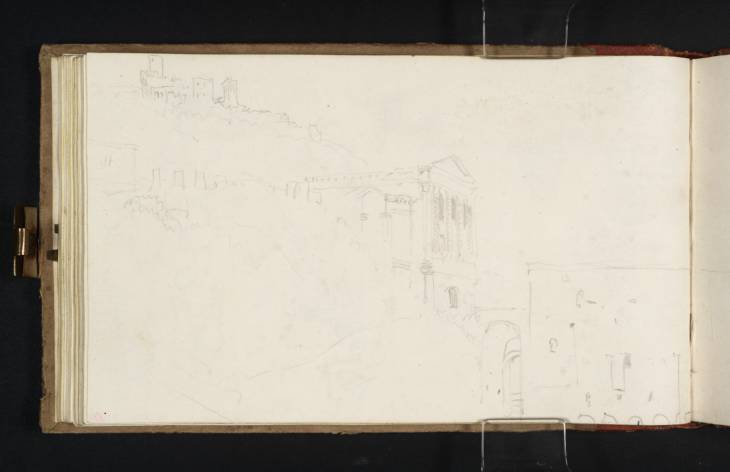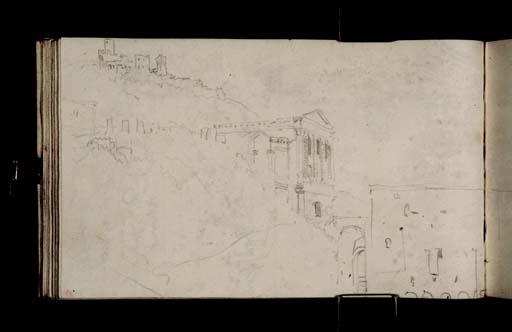Joseph Mallord William Turner The Temple of Clitumnus, Looking up towards Pissignano 1819
Image 1 of 2
Joseph Mallord William Turner,
The Temple of Clitumnus, Looking up towards Pissignano
1819
Joseph Mallord William Turner 1775–1851
Folio 37 Verso:
The Temple of Clitumnus, Looking up towards Pissignano 1819
D14725
Turner Bequest CLXXVII 37 a
Turner Bequest CLXXVII 37 a
Pencil on white wove paper, 110 x 186 mm
Accepted by the nation as part of the Turner Bequest 1856
References
1909
A.J. Finberg, A Complete Inventory of the Drawings of the Turner Bequest, London 1909, vol.I, p.522, as ‘Temple of Clitumnus; three sketches’.
1968
Giovanni Carandente, ‘Un Viaggio di Turner in Umbria’, Spoletium: Rivista di arte, storia e cultura, no.13, April 1968, p.18 note 13, as ‘una veduta generale del Tempietto con Campello sullo sfondo’.
1984
Cecilia Powell, ‘Turner on Classic Ground: His Visits to Central and Southern Italy and Related Paintings and Drawings’, unpublished Ph.D thesis, Courtauld Institute of Art, University of London 1984, pp.355 note 31, 356, reproduced pl.208, as ‘The Temple of Clitumnus’.
1987
John Gage, J.M.W. Turner: ‘A Wonderful Range of Mind’, New Haven and London 1987, p.48.
1987
Cecilia Powell, Turner in the South: Rome, Naples, Florence, New Haven and London 1987, p.170, reproduced pl.162, as ‘The Temple of Clitumnus’.
One of the most celebrated ancient monuments to be found outside of Rome was the Temple of Clitumnus (Tempietto sul Clitunno), a small structure dating from between the fourth to the eighth centuries, located on the road between Foligno and Spoleto in Umbria. Originally a pagan place of worship devoted to the divinity of the Clitumnus River, the source of which lies nearby, the building was later adopted as a Christian chapel, the Church of San Salvatore. This sketch depicts a complete view of the temple looking up from the banks of the stream to the north-west. On the slopes of the hill to the left is the medieval fortress of Pissignano, see folios 36 (D14722) and 36 verso (D14723), whilst on the right just beneath the temple is part of an old grain and oil mill built beside the stream. This building still exists today as a hotel.1 As John Chetwode Eustace described in A Classical Tour Through Italy, the temple consists of:
the cella and a Corinthian portico, supported by four pillars and two pilasters; the pilasters are fluted; two of the pillars are indented with two spiral lines winding round, and two ornamented with a light sculpture representing the scales of fish. The inscription on the frieze is singular, “Deus angelorum, qui fecit resurrectionem.” Underneath is a vault or crypta: the entrance is on the side as the portico hangs over the river; the walls are solid, the proportions beautiful, and the whole worthy of the Romans, to whom it is ascribed.2
In preparation for his first trip to Italy Turner made detailed notes from this passage in the Italian Guide Book sketchbook (see Tate D13939; Turner Bequest CLXXII 4a).
During the eighteenth and nineteenth centuries the temple was a well-known landmark for travellers on the Via Flaminia, adjacent as it was to the first post stage after Foligno, Le Vene.3 It was also a popular subject for artists and writers and Turner would have been familiar with its appearance from various other contemporary sources. As a young man he had made a study of Richard Wilson’s painting Temple of Clitumnus 1754, 4 which at the time was owned by the Prince of Wales, although it is not clear whether Turner worked from the original or from a reproductive print (see Wilson sketchbook, Tate D01195–D01196; Turner Bequest XXXVII 78–9).5 A tiny pen-and-ink view of the temple appears in the Italian Guide Book sketchbook, copied from John ‘Warwick’ Smith’s Select Views in Italy (see Tate D13964; Turner Bequest CLXXII 18, second from top left). Turner was also familiar with Stourhead, the estate of his friend and patron, Sir Richard Colt Hoare, the gardens of which contained a structure inspired by the Corinthian temple, the Temple of Flora, built in 1744–6 by the architect Henry Flitcroft.6 Furthermore, he may also have seen other images of it such as a lecture diagram of the elevation and plan of the portico by his friend, Sir John Soane (John Soane Museum, London), or a topographical drawing by James Hakewill, his collaborator on Picturesque Views in Italy, published 1819.7
Above all, Turner would have been mindful of the verses devoted to the temple and the nearby Source of the Clitumnus from Canto IV of Lord Byron’s Childe Harold’s Pilgrimage, published in 1818:
But thou, Clitumnus: In thy sweetest wave
Of most living crystal that was e’er
The haunt of river nymph, to gaze and lave
Her limbs where nothing hid them, thou dost rear
Thy grassy banks whereon the milk-white steer
Grazes; the purest god of gentle waters;
And most serene of aspect, and most clear;
Surely that stream was unprofaned by slaughters –
A mirror and a bath for Beauty’s youngest daughters:
Of most living crystal that was e’er
The haunt of river nymph, to gaze and lave
Her limbs where nothing hid them, thou dost rear
Thy grassy banks whereon the milk-white steer
Grazes; the purest god of gentle waters;
And most serene of aspect, and most clear;
Surely that stream was unprofaned by slaughters –
A mirror and a bath for Beauty’s youngest daughters:
And on thy happy shore a Temple still,
Of small and delicate proportion, keeps,
Upon a mighty declivity of hill,
Its memory of thee; beneath it sweeps
Thy current’s calmness; oft from out it leaps
The finny darter with the glittering scales,
Who dwells and revels in thy glassy deeps;
White, chance, some scatter’d water-lily sails
Down where the shallower wave still tells it bubbling tales.
Of small and delicate proportion, keeps,
Upon a mighty declivity of hill,
Its memory of thee; beneath it sweeps
Thy current’s calmness; oft from out it leaps
The finny darter with the glittering scales,
Who dwells and revels in thy glassy deeps;
White, chance, some scatter’d water-lily sails
Down where the shallower wave still tells it bubbling tales.
(‘Canto IV’, verses LXVI and LXVII)
In 1832 Turner exhibited a visual homage to Byron, a large oil painting Childe Harold’s Pilgrimage – Italy (Tate, N00516) accompanied by a quotation which begins ‘and now, fair Italy! Thou art the garden of the world’.8 As Cecilia Powell has noted the landscape composition contains a panoramic amalgam of many individual places Turner had visited on his Italian travels, including a classical portico based upon the Temple of Clitumnus.9 The appearance of the structure is most similar to the prospect of the temple in this drawing.
Turner’s other on-the-spot sketches of the site explore the situation of the temple from both the north, see folios 35 (D14720), 36 (D14722) and 36 verso (D14723), and the south, see folios 37 (D14724) and 38 (D14726). He also made detailed studies of the parts of the façade such as the Corinthian pillars, the tympanum above the portico and the inscription across the front, see folios 36 verso (D14723) and 37 (D14724). There are no sketches, however, of the vaulted interior decorated with frescoes so it is possible that he did not have the inclination or the leisure to explore inside.
Nicola Moorby
November 2008
Sold at Important British Paintings, Watercolours and Drawings, Sotheby’s, London, 14 June 2001, lot.8 as An Italian river scene with the Temple of Clitumnus and ruins, two figures and cows in foreground.
National Trust website, http://www.nationaltrust.org.uk/main/w–vh/w–visits/w–findaplace/w–stourhead/w–stourhead–garden/w–stourhead–garden–architecture.htm, accessed November 2008.
Temple of Jupiter Clitumnus, near La Vene 1817, British School at Rome Library, see Tony Cubberley and Luke Herrmann, Twilight of the Grand Tour: A Catalogue of the drawings by James Hakewill in the British School at Rome Library, Rome 1992, no.2.49, p.166 reproduced.
How to cite
Nicola Moorby, ‘The Temple of Clitumnus, Looking up towards Pissignano 1819 by Joseph Mallord William Turner’, catalogue entry, November 2008, in David Blayney Brown (ed.), J.M.W. Turner: Sketchbooks, Drawings and Watercolours, Tate Research Publication, December 2012, https://www


